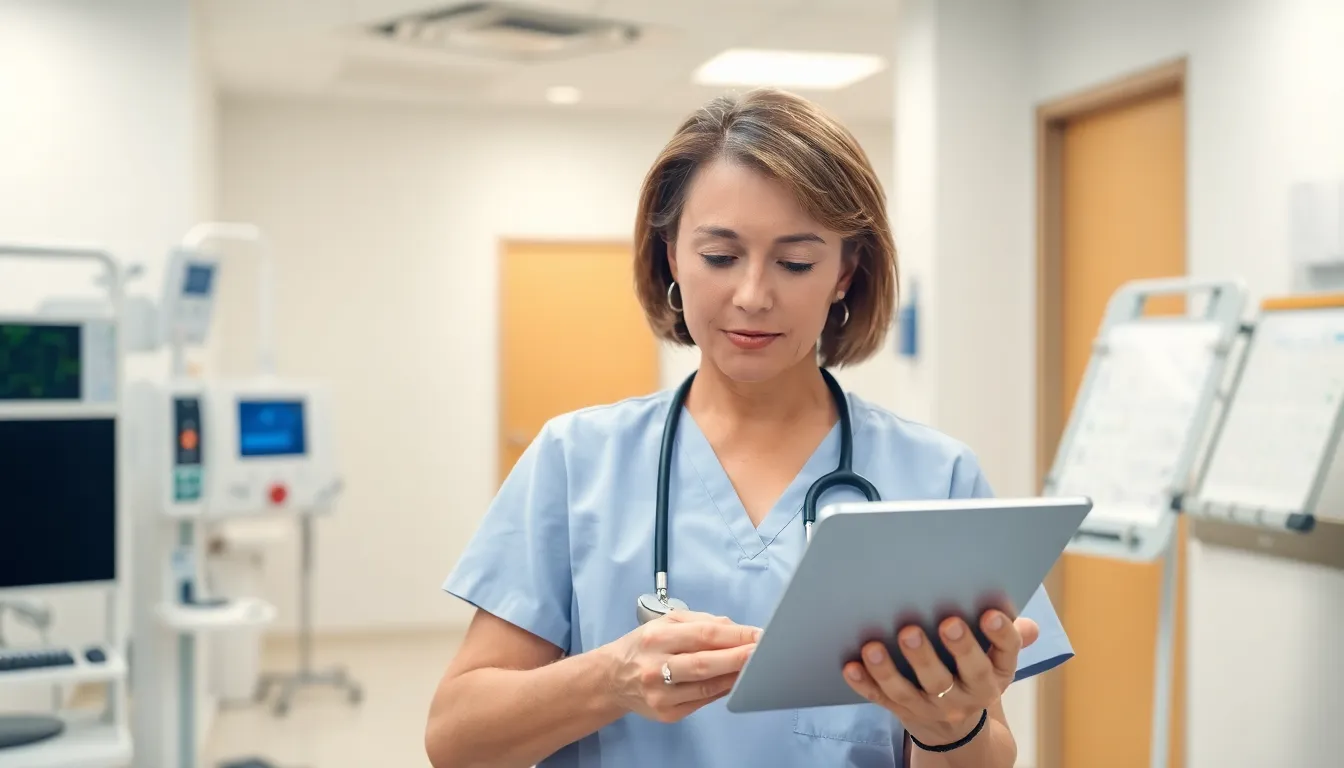In a world where even your toaster can connect to the internet, it’s no surprise that healthcare has jumped on the tech bandwagon. Enter healthcare informatics, the superhero of the medical field, swooping in to save the day with data. Imagine a realm where doctors and nurses harness the power of information to enhance patient care and streamline operations—all while avoiding the chaos of paper charts and lost files.
What Is Healthcare Informatics
Healthcare informatics refers to the systematic integration of information technology in healthcare settings. This field encompasses the collection, storage, and analysis of health data to enhance patient care. By utilizing electronic health records (EHRs), healthcare informatics supports efficient communication among healthcare providers.
Data management plays a vital role in healthcare informatics. Effective management of patient information leads to better decision-making and improved treatment outcomes. It also fosters the sharing of data across different departments, leading to coordinated care and reduced errors.
Healthcare informatics contributes to various areas within the healthcare system, such as clinical informatics and public health informatics. Clinical informatics focuses on improving clinical workflows through technology. Public health informatics emphasizes the use of data to monitor and improve population health.
Technology advancements drive the evolution of healthcare informatics. Innovations such as telemedicine and wearable health devices offer new ways for patients to interact with healthcare providers. These advancements enhance remote patient monitoring, increasing access to care.
Regulatory compliance remains a significant aspect of healthcare informatics. Adhering to standards like HIPAA ensures that patient data remains secure and confidential. This compliance bolsters trust between patients and healthcare providers.
Healthcare informatics serves as a critical component in modern medicine. By leveraging technology and data, this field revolutionizes patient care and transforms healthcare operations. Organizations that embrace healthcare informatics position themselves to provide high-quality care while optimizing resources.
Importance of Healthcare Informatics

Healthcare informatics plays a pivotal role in transforming patient care and operational efficiency in medical settings. It leverages data and technology to enhance the overall healthcare experience.
Enhancing Patient Care
Improved patient care results from the effective use of electronic health records. These records facilitate seamless communication among healthcare providers, ensuring that critical information is shared promptly. Data-driven insights lead to better decision-making, allowing for personalized treatment plans. Enhancements in remote monitoring through telemedicine enable constant patient engagement. Patients benefit from timely interventions due to coordinated care efforts. Consequently, healthcare informatics reduces the possibility of errors, significantly improving treatment outcomes.
Streamlining Operations

Streamlined operations emerge from the integration of healthcare informatics. Efficiencies in administrative tasks arise through automated processes that reduce manual data entry. The use of analytics improves resource allocation, aligning staff and equipment where needed most. Process optimization leads to shorter wait times and increased patient throughput. Additionally, compliance with regulations becomes simpler, as systems automatically update to meet standards. Overall, these advancements position healthcare organizations to operate effectively while providing high-quality services.
Key Components of Healthcare Informatics
Healthcare informatics encompasses several key components that enhance patient care and operational efficiency. The most prominent elements include electronic health records and health information exchange.
Electronic Health Records (EHR)
Electronic health records streamline patient information management. EHRs consolidate data into a single digital file accessible to authorized healthcare providers. They facilitate real-time updates, promoting continuity of care. Enhanced communication occurs when providers share patient data seamlessly, reducing duplicate tests and fostering informed decision-making. Moreover, EHRs support collaboration across specialties, ensuring comprehensive treatment plans tailored to individual needs.
Health Information Exchange (HIE)
Health information exchange empowers healthcare providers to share patient health data securely. HIE enables timely access to vital information, especially during emergencies. When providers exchange data, they enhance care coordination and decrease delays in diagnosis and treatment. HIE improves health outcomes by linking patient histories across facilities, offering a complete view of a patient’s medical journey. Enhanced interoperability between systems promotes efficient data flow and reinforces the commitment to quality patient care.
Challenges in Healthcare Informatics
Healthcare informatics faces several challenges that can impact its effectiveness in improving patient care and operational efficiency. Notably, these challenges include data privacy and security as well as interoperability issues.
Data Privacy and Security
Maintaining data privacy and security remains a significant challenge in healthcare informatics. Electronic health records (EHRs) contain sensitive patient information, making them attractive targets for cyberattacks. Organizations must adopt robust security measures, such as encryption and access controls, to protect personal health data. Compliance with regulations, particularly the Health Insurance Portability and Accountability Act (HIPAA), is essential for legal protection and maintaining patient trust. Assurance of proper data handling fosters confidence in healthcare systems. Providers must also educate staff about data privacy practices to mitigate risks associated with human error.
Interoperability Issues
Interoperability issues hinder the seamless exchange of information between healthcare systems. Lack of standardization often results in fragmented data storage, impeding communication among providers. Overcoming this barrier involves implementing standardized protocols for data sharing, allowing systems to communicate effectively. Organizations benefit from enhanced interoperability as it improves care coordination and reduces delays in diagnosis and treatment. Additionally, without proper interoperability, patient care continuity suffers, leading to potential duplicate tests and inconsistent treatment plans. Efforts to establish comprehensive health information exchanges (HIEs) can significantly enhance collaboration among providers, ultimately improving patient outcomes.
Future Trends in Healthcare Informatics
Healthcare informatics continuously evolves, integrating advanced technologies to enhance patient care and operational efficiency. Current trends indicate significant shifts toward artificial intelligence and telehealth.
Artificial Intelligence Integration
Artificial intelligence (AI) transforms healthcare informatics by improving data analysis and decision-making. AI algorithms analyze patient data for predictive analytics, enabling healthcare providers to anticipate outcomes and tailor treatments. Machine learning applications enhance diagnostic accuracy, significantly reducing errors. Chatbots assist in patient engagement, addressing inquiries and managing appointments seamlessly. These innovations lead to personalized patient care, enhancing overall treatment experiences. Institutions adopting AI can increase operational efficiency while benefiting from improved workflows and resource allocation.
Telehealth Advancements
Telehealth plays a pivotal role in modern healthcare informatics, expanding access to services and enhancing patient engagement. Virtual consultations allow patients to connect with providers without geographical barriers, leading to increased treatment adherence. Mobile health applications empower patients to monitor health conditions in real-time, fostering proactive health management. Remote patient monitoring technologies facilitate continuous health assessments, improving outcomes through timely interventions. Telehealth advancements contribute to the shift towards patient-centered care by making healthcare more accessible and convenient for diverse populations.


